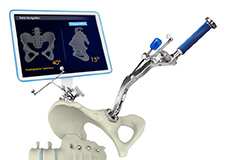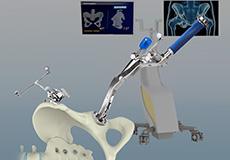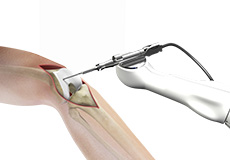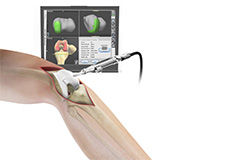- Computer Assisted Hip Replacement
- Computer Assisted Knee Replacement

What is Computer-assisted Hip Replacement?
Computer-assisted hip replacement is an image-guided, minimally invasive surgical procedure to replace your diseased or damaged hip with an artificial device using the assistance of computer software. The system creates and displays images and provides information that aids your surgeon at various stages of the procedure to improve accuracy and results.
Components of the Computer-assisted System
The computer-assisted system has three basic components:
- A special navigation camera that visualizes your hip joint and creates images
- Smart instruments that can be tracked by the camera
- Computer with specialized surgical navigation software to integrate the images with surgical information
Advantages of Computer-assisted Hip Replacement
Some of the potential advantages of computer-assisted hip replacement include:
- Better accuracy in sizing and positioning of your hip implant
- Improved functional outcome and stability
- Improved durability of the implant
- Reduced risk of leg-length discrepancies
- Minimal postoperative pain

Procedure for Computer-assisted Hip Replacement
Computer-assisted hip replacement is performed in the following manner:
- Spinal anesthesia is administered
- The smart instruments are introduced into the hip and specific anatomic bony landmarks are located with the help of the camera
- This information is relayed to the computer which generates a virtual model of your hip joint and provides information to help your doctor plan and perform the surgery
- The appropriate implant size is determined and your doctor makes precise cuts in your bone to place the implant in the desired position
- The instruments are removed and the incisions are closed with sutures
Your operation may take one to one and a half hours depending on the complexity.
Post-surgery Protocol and Care
After your operation, you will be closely monitored for several hours and will remain in the hospital for a few days. Usually, you are encouraged to sit and stand a day after your surgery and will start walking with a walker and then a cane over the next few days. You may be discharged when you can ambulate well with the help of a cane and are advised about:
- Postoperative precautions
- Post-surgery exercises
- Follow-up
Recovery After Computer-assisted Hip Replacement
In about four to six weeks, you should be able to walk on your own. It may take you a few months to achieve full recovery.
Potential Complications Associated with Computer-assisted Hip Replacement
Complications of computer-assisted hip replacement are very rare (less than 1%). The pins used to attach the smart instruments to the bones in the hip can occasionally undergo fracture or cause infection. Other complications include:
- Dislocations (rarely)
- Nerve or vascular damage
- Clot formation

What is Total Knee Replacement?
A total knee replacement surgery involves replacing the damaged surfaces of the articulating bones with artificial implants. Most of these implants wear with use. Thus, the need for revision surgery is high if you are young and active, and if the implant must last your lifetime. Precise alignment can help extend the life of the implants and this can be achieved using computer navigation for total knee replacement surgery.
Indications for Total Knee Replacement
A total knee replacement surgery is the last resort to relieve pain and restore function in the knee that is damaged by arthritis or an injury when non-surgical treatments do not relieve the condition.
Computer Navigation for Total Knee Replacement
Computer navigation provides your surgeon with real-time 3-D images of your mapped knee and the surgical instruments during surgery. The data for the images is provided by infrared sensors fixed to the bones of the knee and surgical instruments. Their position is tracked by an infrared camera placed above the surgical table, which is connected to a computer. The computer then generates real-time images with the help of the appropriate software to guide your surgeon to precisely resurface and cut the bones of the knee, and fix the implant precisely and accurately according to the preoperative surgical plan.

The surgery is performed entirely by your surgeon. Computer navigation is just a tool to guide your surgeon and ensure accuracy. It cannot replace the skills of an experienced surgeon.
Advantages of Computer Navigation for Total Knee Replacement
Computer navigation for total knee replacement has the following advantages:
- Allows accurate positioning of the knee prosthesis in relation to the mechanical axis of the leg
- Accurate alignment helps lower the rate of wear and tear and improves longevity of the implants
- May improve soft-tissue balancing
- Offers better functional outcome
- Lower loss of blood






